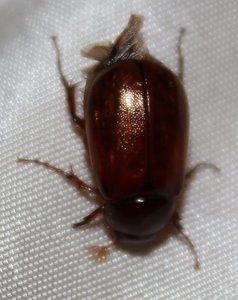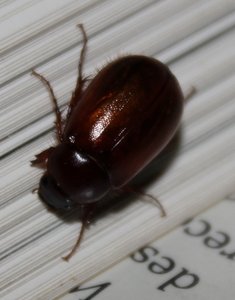Christmas Beetle
Popped in while I was reading, circled the light a few times and hit me, landing on my book. Was gone on the morning ...
Comments
To identify a flying peanut.
To identify a flying peanut (whether Melolonthinae or Rutelinae), even to genus level, from a habitus photograph, is impossible except for a small number of "obvious" species (and even then there is doubt).
To identify a flying peanut one should clearly keep in mind that there are two major scarab subfamilies plus some odd others that contain flying peanuts. And there are hundreds of species in numerous genera in several tribes, which higher taxa are not even all that easy to distinguish. Moreover, it is known that there is a considerable number of flying peanut species that have not been named/described yet, and that there are simultaneously synonymies lurking among the bounty.
To identify a flying peanut to species level I need at least the following: (1) a good series of real specimens, intact; (2) both luck and perseverance, coupled to generally 2-3 hours per peanut species; (3) literature galore, with the primary reference being Louis Péringuey's monographs from 1904 to 1908; (4) good, clear views of at least all details of the claws, the configuration, shape, size and curvature of numerous spines on the legs, detail of the lines on the head, the absence/presence and configuration of teeth on the maxillae ("2nd jaws"), the shape of the labrum ("upper lip") and the anteriormost margin of the head, the size, shape, density and depth of tiny punctures on various parts of the body, the shape, size, angle, length and colour of microscopic hairs (setae) on various parts of the body, the nature of any hairs on specific parts of the underside of the beetle, AND a nice dissection of the internal male genitalia. Sometimes the last-mentioned structures are sufficient on their own (but then you may have a series of 12 females and no single male ... it happens), and at other times it is necessary to investigate all the structures listed, plus quite a few others.
To identify a flying peanut is, well, difficult. And to identify their important larvae (= white grubs) is simply impossible.
.
------You wrote:
>>>These Flying Peanuts deserve more attention: they are clearly important service providers judging by their abundance...
My response is a resounding YES. There have been several rather unsuccessful attempts in southern Africa before, and there are more than one local postgrad currently working on the problem and more than one ARC and SASRI project dealing with whitegrubs (all, of course, in a sylvicultural/horticultural/agricultural context). DNA sequence data holds some promise, but not without solid alpha taxonomy {which I am not paid to do on flying peanuts, so don't blame me in this life}. But still we actually need an entire Institute for the Study of African Flying Peanuts.
-- Beetledude
Wow - quite a tome
Wow - quite a tome, and you have only dealt with the generalities.
Simply Flying Peanuts is obviously a very efficient morphology, and lots of larvae are using it as a means to reproduction.
However, you intimate that the larvae are also impossible to identify (for similar reasons).
Forget DNA: it only works when all (OK 90%+) the species are known.
All that remains it so convince someone with money that Flying Peanuts are the bread and butter of silviculture/horticulture/agriculture - and it seems as if the beetles are doing that already.
The alternative is to convince the powers that bee, that you have been a naughty grub, and in your next few hundred instars you must return and sort out the Flying Peanuts.
You really have a way to say a thing
I really like the way you put this phrase: Flying Peanut is obviously a very efficient morphology, and lots of larvae are using it as a means to reproduction. There is a lot of truth in there, as the ecologically/economically significant life stage indeed is the larva (= white grub), and the flying peanuts just help them reproduce.
I may have neglected (in my tome, above) to stress the fact that 90% of the economic damage/ecological good is done by the white grubs, which all look like white grubs. Apart from different white grubs being really similar morphologically, an incredible and perpetual problem is that for no more than a handful of species the larval stages and the adult stage have been matched. It is as if white grubs are one set of taxa (unidentifiable) and their (same species) adult stages have a different taxonomy (rudimentary).
I agree completely that the silver bullet is not DNA, but rather a hard and long, unfashionable and old-fashioned, slog at real taxonomy. Which is being done, mind you, by a tiny number of workers locally and abroad (working on our fauna). The progress is slow, but I do not believe that DNA barcoding will be an answer to this whole dilemma either.
But it is soooo fashionable!
-- Beetledude
We need more insect taxonomists

Dear Tony, Basically South Africa needs NBI / SANBI's for each order of insects / invertebrates. Thus, there could be one just for beetles, flies, etc. Then, and after 1001 revisions and even more species descriptions we would be on a par with some of the better known taxon specialists in being able to provide accurate species level identifications for even some of our commonly encountered insects.
Best regards
James du G. H.
Life Cycle etc...
I came across this page while trying to do some research on these insects. I am particularly attempting to find out more about the larvae of flying peanuts, sepcifically what their life cycle looks like, how long they take to reach maturity, what they consume, in which environment they are kept, and whether they are food for any predators.
These really are a part of South Africa as I know it.
Time?
Wecome to iSpot, Ruan. Some of us live here.
When do you need this information? It's a lot of info, and in actual fact we know zilch about the biologies of the local fauna.
Do you have access to a university library?
-- Beetledude
predators:
see http://za.ispot.org.uk/node/145548
What sort of impact do 'invading' spiders have on the local fauna?
This is in the same category as:
What sort of impact do 'invading' Guineafowl have on our local bulbs?
What sort of impact do 'invading' Hadedahs have on our local frogs (esp. Rainfrogs) and skinks?
Larva
http://za.ispot.org.uk/node/149602.
-- Beetledude
Another species of Camenta

Family Scarabaeidae
Subfamily Melolothinae
Tribe ABLABERINI Blanchard, 1850
Genus Camenta Erichson, 1847
A species of Camenta. James du G. H.







Still devastated ....
Still devastated that I cannot get a positive ID for so common and important an insect.
These Flying Peanuts deserve more attention: they are clearly important service providers judging by their abundance...